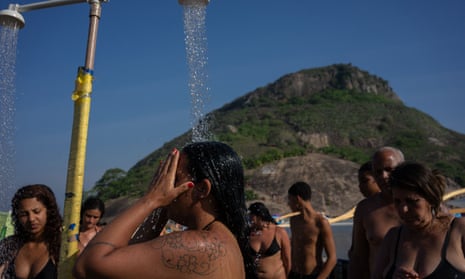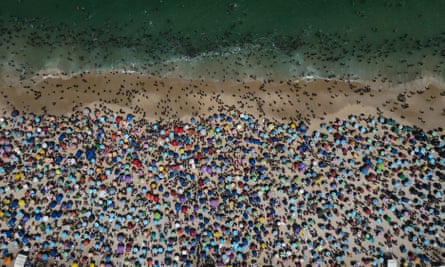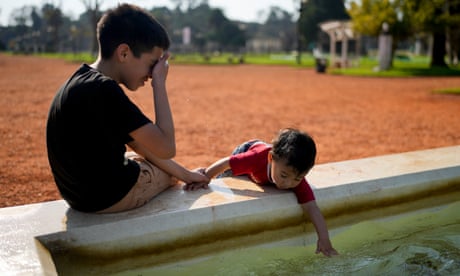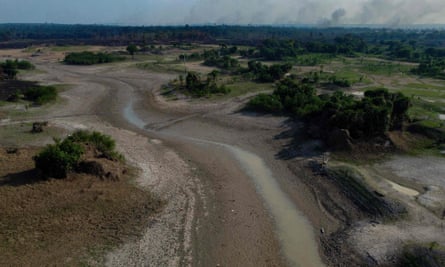Brazil bakes as mercilessly hot spring begins
Having just emerged from its warmest winter since 1961, the country is sweltering amid unforgiving and unseasonal temperatures
Tom Phillips in Rio de Janeiro and Constance Malleret in São Paulo

Having just emerged from its warmest winter since 1961, the country is sweltering amid unforgiving and unseasonal temperatures
Tom Phillips in Rio de Janeiro and Constance Malleret in São Paulo
THE GUARDIAN
Tue 26 Sep 2023

People cool off at Macumba beach, in the west zone of Rio de Janeiro, on Sunday. Photograph: Tercio Teixeira/AFP/Getty Images
A ferocious heatwave was sweeping South America, and samba composer Beto Gago (Stuttering Bob) saw only one thing to do: pop out for an ice-cold beer with his drinking buddy Joel Saideira – Last Order Joel.
“Damn, it was grim around here yesterday,” the 76-year-old musician grimaced as he stood outside his home in Irajá – reputedly Rio’s hottest neighbourhood – with a bohemian’s potbelly spilling out over his lilac shorts.
“It was bloody miserable. Even Lucifer was using a fan! He couldn’t bear the heat either!” chuckled Gago’s son, a 36-year-old sambista called Juninho Thybau.
Irajá – a No 3-shaped chunk of north Rio famed for its samba stars and oppressive heat – is far from the only corner of Brazil that has been baking under unforgiving and unseasonal temperatures. Having just emerged from its warmest winter since 1961, South America’s largest country is experiencing a mercilessly hot start to spring.
With temperatures soaring towards – and in some places over 40C (104F) – newspapers and weather forecasters have drawn comparisons with global hotspots including Iraq, Iran, Saudi Arabia and even Dallol, Ethiopia, which is reputedly the world’s hottest inhabited place.


A ferocious heatwave was sweeping South America, and samba composer Beto Gago (Stuttering Bob) saw only one thing to do: pop out for an ice-cold beer with his drinking buddy Joel Saideira – Last Order Joel.
“Damn, it was grim around here yesterday,” the 76-year-old musician grimaced as he stood outside his home in Irajá – reputedly Rio’s hottest neighbourhood – with a bohemian’s potbelly spilling out over his lilac shorts.
“It was bloody miserable. Even Lucifer was using a fan! He couldn’t bear the heat either!” chuckled Gago’s son, a 36-year-old sambista called Juninho Thybau.
Irajá – a No 3-shaped chunk of north Rio famed for its samba stars and oppressive heat – is far from the only corner of Brazil that has been baking under unforgiving and unseasonal temperatures. Having just emerged from its warmest winter since 1961, South America’s largest country is experiencing a mercilessly hot start to spring.
With temperatures soaring towards – and in some places over 40C (104F) – newspapers and weather forecasters have drawn comparisons with global hotspots including Iraq, Iran, Saudi Arabia and even Dallol, Ethiopia, which is reputedly the world’s hottest inhabited place.

People visit Ipanema beach in Rio de Janeiro amid the heat. Photograph: António Lacerda/EPA
In the town of São Romão, in Minas Gerais state, temperatures hit 43C on Monday – “only two degrees less than in the Sahara desert”, reported one local newspaper. A week earlier, Irajá’s residents endured 41C temperatures – “higher than Death Valley in California”, according to the television news.
Even São Paulo, supposedly Brazil’s cloudy “Land of Drizzle”, is sweltering, with temperatures hitting 36.5C on Sunday – its sixth hottest day since 1943.
Neighbouring Paraguay – where the rural town of Filadelfia suffered 44.4C heat – and Peru – where the mercury rose to 40.3C in the Amazon outpost of Puerto Esperanza – are also feeling the burn, as is north Argentina.
“I don’t know much about meteorology, but ... it’s definitely getting hotter. The whole world is, isn’t it?” Juninho Thybau said on Monday, as Rio’s most stifling post code braced for more extreme weather.
On the evening news, a weather presenter, Priscila Chagas, warned Wednesday could be the hottest day of 2023. “This is the crazy spring,” she declared, forecasting temperatures of 41C.
Climatologist Karina Bruno Lima said the succession of record-breaking temperatures was unusual and “extremely concerning”. The heatwave follows a similar hot spell in August – shortly after the world’s hottest month on record – during the southern hemisphere winter.

‘Winter is disappearing’: South America hit by ‘brutal’ unseasonal heatwave
Lima believed more research was needed to determine precisely how climate change affected individual weather events. But “we’re already in a context of a changing climate, of a warmer atmosphere and oceans, and we must understand that more frequent and more intense extreme weather events are now a systemic occurrence”.
Experts partly blame the heat on the climate-heating event El Niño, which also causes flooding in some regions. “But it’s not the main factor,” argued Lima, from Rio Grande do Sul’s federal university. “The main factor truly is anthropogenic global heating.”
“In much of the world we can observe an increase in heat-related extreme events. And in Brazil, and South America overall, the tendency is for this to get worse.”

In the town of São Romão, in Minas Gerais state, temperatures hit 43C on Monday – “only two degrees less than in the Sahara desert”, reported one local newspaper. A week earlier, Irajá’s residents endured 41C temperatures – “higher than Death Valley in California”, according to the television news.
Even São Paulo, supposedly Brazil’s cloudy “Land of Drizzle”, is sweltering, with temperatures hitting 36.5C on Sunday – its sixth hottest day since 1943.
Neighbouring Paraguay – where the rural town of Filadelfia suffered 44.4C heat – and Peru – where the mercury rose to 40.3C in the Amazon outpost of Puerto Esperanza – are also feeling the burn, as is north Argentina.
“I don’t know much about meteorology, but ... it’s definitely getting hotter. The whole world is, isn’t it?” Juninho Thybau said on Monday, as Rio’s most stifling post code braced for more extreme weather.
On the evening news, a weather presenter, Priscila Chagas, warned Wednesday could be the hottest day of 2023. “This is the crazy spring,” she declared, forecasting temperatures of 41C.
Climatologist Karina Bruno Lima said the succession of record-breaking temperatures was unusual and “extremely concerning”. The heatwave follows a similar hot spell in August – shortly after the world’s hottest month on record – during the southern hemisphere winter.

‘Winter is disappearing’: South America hit by ‘brutal’ unseasonal heatwave
Lima believed more research was needed to determine precisely how climate change affected individual weather events. But “we’re already in a context of a changing climate, of a warmer atmosphere and oceans, and we must understand that more frequent and more intense extreme weather events are now a systemic occurrence”.
Experts partly blame the heat on the climate-heating event El Niño, which also causes flooding in some regions. “But it’s not the main factor,” argued Lima, from Rio Grande do Sul’s federal university. “The main factor truly is anthropogenic global heating.”
“In much of the world we can observe an increase in heat-related extreme events. And in Brazil, and South America overall, the tendency is for this to get worse.”

An aerial view of the Rio Negro with very low water levels at the Cacau Pirera district in Iranduba, Amazonas state.
Photograph: Michael Dantas/AFP/Getty Images
That is bad news for the 100,000 residents of already-scorching Irajá, which also suffers from being dissected by Avenida Brasil, one of Rio’s busiest and most polluted motorways.
As he shot the breeze on his veranda, Beto Gago reminisced about his childhood in the neighbourhood during the 1950s. Hog plum, guava and mango trees were everywhere. Nearby forests were still standing and kept temperatures down. “It was always hot around here. But there used to be this cool breeze,” remembered the shirtless sambista.
“These days, it’s hard to tell which neighbourhood’s the coolest because the whole of Rio is bloody roasting,” said his son.
That is bad news for the 100,000 residents of already-scorching Irajá, which also suffers from being dissected by Avenida Brasil, one of Rio’s busiest and most polluted motorways.
As he shot the breeze on his veranda, Beto Gago reminisced about his childhood in the neighbourhood during the 1950s. Hog plum, guava and mango trees were everywhere. Nearby forests were still standing and kept temperatures down. “It was always hot around here. But there used to be this cool breeze,” remembered the shirtless sambista.
“These days, it’s hard to tell which neighbourhood’s the coolest because the whole of Rio is bloody roasting,” said his son.

Samba composer Beto Gago (Stuttering Bob) with his son, Juninho Thybau.
Photograph: Alan Lima
Nearby, at Irajá’s sprawling food distribution centre – reputedly Latin America’s second largest – sweat-drenched workers stacked fruit onto handcarts despite the relentless heat. “You sweat in the shade and, if you stay in the sun, you melt like an ice lolly,” joked Geraldo Lima, 56, a homeless man who earns about £8 a day loading trucks.
Lima was unsure if global heating was the culprit: “The truth is only God knows.” But market workers were certain temperatures were rising. “Each day’s worse than the last,” said Thiago dos Santos, a 17-year-old porter, as he hauled dozens of wooden crates off to a neighbouring favela for recycling.
Juninho Thybau, who is the nephew of Brazil’s most famous samba musician, Zeca Pagodinho, insisted Irajá remained the city’s best place to live and was not Rio’s only extreme heat hotspot.
He remembered a recent performance in nearby Nilópolis, another area famed for its samba scene and blistering heat. “Holy shit, brother, it was so hot it felt like I was in hell,” he said, fretting that the worst was still to come.
Thybau, who holds a monthly jam session outside his house, said a friend at city hall had warned him “a catastrophe” was heading Rio’s way with the start of summer in December likely to bring heavy rains and more severe heat.
Other adaptation methods beside ice-cold would be needed if the samba was to go on. “We’re going to have to hire a water tanker to soak the crowd – or one of those fans that pumps out water.”
Nearby, at Irajá’s sprawling food distribution centre – reputedly Latin America’s second largest – sweat-drenched workers stacked fruit onto handcarts despite the relentless heat. “You sweat in the shade and, if you stay in the sun, you melt like an ice lolly,” joked Geraldo Lima, 56, a homeless man who earns about £8 a day loading trucks.
Lima was unsure if global heating was the culprit: “The truth is only God knows.” But market workers were certain temperatures were rising. “Each day’s worse than the last,” said Thiago dos Santos, a 17-year-old porter, as he hauled dozens of wooden crates off to a neighbouring favela for recycling.
Juninho Thybau, who is the nephew of Brazil’s most famous samba musician, Zeca Pagodinho, insisted Irajá remained the city’s best place to live and was not Rio’s only extreme heat hotspot.
He remembered a recent performance in nearby Nilópolis, another area famed for its samba scene and blistering heat. “Holy shit, brother, it was so hot it felt like I was in hell,” he said, fretting that the worst was still to come.
Thybau, who holds a monthly jam session outside his house, said a friend at city hall had warned him “a catastrophe” was heading Rio’s way with the start of summer in December likely to bring heavy rains and more severe heat.
Other adaptation methods beside ice-cold would be needed if the samba was to go on. “We’re going to have to hire a water tanker to soak the crowd – or one of those fans that pumps out water.”

No comments:
Post a Comment